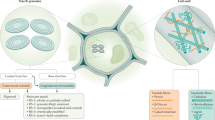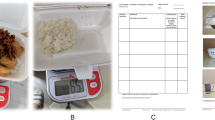Abstract
Objective: To compare the intakes of dietary fibre (DF) and dietary indigestible fraction (DIF) in the Spanish diet and also to show the limitations of DF values for nutritional and epidemiological studies.
Design: This includes the following: (i) estimation of plant foods consumption in Spanish diet from national food consumption data obtained from annual surveys (6000 households, 700 hotels and restaurants and 200 institutions); (ii) determination of DIF content in plant foods using analytical methods that mimic physiological conditions; (iii) estimation of daily intakes of DIF and DF in the Spanish diet.
Results: DIF intake in the Spanish population was estimated at 41.5 g/person/day. DF intake (18.3 g/person/day) was considerably lower than the amount of carbohydrate necessary to maintain the daily bacterial cell turnover in large intestine (‘carbohydrate gap’). The differences between DIF and DF values are a consequence of conceptual and methodological aspects. DIF, as the part of foods reaching the colon, comprises not only DF but also other indigestible compounds such as a fraction of resistant starch, protein, polyphenols and other associated compounds. Analytical conditions are closer to actual physiological conditions in the determination of DIF than in DF analysis.
Conclusions: DF intake underestimates a major part of the dietary substrates that enter the colon. DIF intake more closely matches the amount of substrates needed to maintain a typical human colonic microflora. DIF may be a good alternative to DF for nutritional and epidemiological studies.
This is a preview of subscription content, access via your institution
Access options
Subscribe to this journal
Receive 12 print issues and online access
$259.00 per year
only $21.58 per issue
Buy this article
- Purchase on Springer Link
- Instant access to full article PDF
Prices may be subject to local taxes which are calculated during checkout
Similar content being viewed by others
References
Bazzano LA, He J, Ogden LGO, Loria CM, Vupputuri S, Myers L & Whelton K (2002): Fruit and vegetables intake and risk of cardiovascular disease in US adults: The first National Health and nutrition examination survey epidemiological follow-up study. Am. J. Clin. Nutr. 76, 93–99.
British Nutrition Foundation's Task Force. (1990): Clinical implications of complex carbohydrates for coronary heart disease, In Complex Carbohydrates in Foods, pp 87–93, Chapter 14 London, UK: Chapman & Hall.
Cummings JH (1996): Dietary fibre and fermentation concluding remarks, In Dietary Fibre and Fermentation in the Colon. COST Action 92, eds Y Mälkki & JH Cummings pp 394–398, Brussels: European Commission.
Cummings JH & MacFarlane GT (1991): The control and consequences of bacterial fermentation in the human colon. J. Appl. Bacteriol. 70, 443–459.
Flood A, Vélie EL, Chaterjee N Ch, Subar AF, Thompson FE, Lacey JV, Schairer C, Troisi R & Schatzkin A. (2002): Fruit and vegetable intakes and the risk of colorectal cancer in the breast cancer detection demonstration project follow-up cohort. Am. J. Clin. Nutr. 75, 936–943.
García-Alonso A, Jimenez-Escrig A, Martín-Carrón N, Bravo L & Saura-Calixto F (1999): Assessment of some parameters involved in the gelatinization and retrogradation of starch. Food Chem. 66, 181–187.
German JB & Dillard CJ (1998): Phytochemicals and targets of chronic disease, In Phytochemicals — A New Paradigm, eds WR Bidlack, ST Omaye, MS Meskin & D Jahner Pennsylvania, USA: Technomic Publishing Company Inc.
Goñi I (2001): Dietary fibre intake in Spain: recommendations and actual consumption patterns, In Handbook of Dietary Fibre, eds SS Cho & ML Dreher, Chapter 39 New York. USA: Marcel-Dekker.
Goñi I, García-Diz L, Mañas E & Saura-Calixto F. (1996): Analysis of resistant starch: a method for foods and food products. Food Chem. 56, 445–449.
Holland B, Welch AA, Unwin ID, Buss DH, Paul AA & Southgate DAT (1995): The Composition of Foods. UK: Royal Society of Chemistry.
Lampe JW (1999): Health effects of vegetables and fruit: assessing mechanism of action in human experimental studies. Am. J. Clin. Nutr. 70 (Suppl), S475–S490.
Lia A, Hallmans G, Sandberg AS, Sundberg B, Aman P & Andersson H (1996): Substrates available for colonic fermentation from oat, barley and wheat diets. A study in ileostomy subjects, In Dietary Fibre and Fermentation in the Colon. COST Action 92, eds Y Mälkki & JH Cummings pp 33–36. Brussels: European Commission.
Mañas E & Saura-Calixto F (1993): Ethanolic precipitation: a source of error in dietary fibre determination. Food Chem. 47, 351–355.
Mañas E & Saura-Calixto F (1995): Dietary fibre analysis: methodological error sources. Eur. J. Clin. Nutr. 49 (Suppl 3), S158–S162.
Martinez-González MA, Fernández-Jarne E, Martínez-Losa E, Prado-Santamaría M, Brugarolas-Brufau C & Serrano-Martínez M. (2002): Role of fibre and fruit in the mediterranean diet to protect against myocardial infarction: a case–control study in Spain. Eur. J. Clin. Nutr. 56, 715–722.
Mennen LI, Potier de Courcy G, Guilland J-C, Ducros V, Bertrais S, Nicolas J-P, Maurel M, Zarebska M, Favier A, Franchisseur C, Hercberg S & Galan P (2002): Homocysteine, cardiovascular disease risk factors, and habitual diet in the French supplementation with antioxidant vitamins and minerals study. Am. J. Clin. Nutr. 76, 1279–1289.
MAPA Ministerio de Agricultura Pesca y Alimentación. (2001): La alimentación en España, 2000. Secretaría General de Agricultura y Alimentación, Madrid, Spain.
Moreiras O, Carbajal A & Cabrera L (1998): Tablas de composición de alimentos, Salamanca, Spain: Ediciones Pirámide.
Potter JD (1990): The epidemiology of fibre and colorectal cancer. Why don't the analytical epidemiologic data make better sense? In: Dietary Fibre. Chemistry, Physiology, and Health Effects, eds D Kritchevsky D, Ch Bonfield & JW Anderson, Chapter 32 New York. USA: Plenum Press.
Saura-Calixto F, García-Alonso A, Goñi I & Bravo L (2000): In vitro determination of the indigestible fraction in foods: an alternative to dietary fibre analysis. J. Agric. Food Chem. 48, 3342–3347.
Serra-Majem L & Aranceta J (2001): Nutritional objectives for the Spanish population. Consensus from the Spanish Society for Community Nutrition. Public Health Nutr. 4, 1409–1413.
Vinson JA, Su X, Zubik L & Bose P (2001): Phenol antioxidant quantity and quality in foods: fruits. J. Agric. Food Chem. 49, 5315–5321.
Author information
Authors and Affiliations
Contributions
Guarantor: F Saura-Calixto.
Contributors: Both authors have contributed to the design and development of the study, interpretation of data and writing the manuscript.
Corresponding author
Rights and permissions
About this article
Cite this article
Saura-Calixto, F., Goñi, I. The intake of dietary indigestible fraction in the Spanish diet shows the limitations of dietary fibre data for nutritional studies. Eur J Clin Nutr 58, 1078–1082 (2004). https://doi.org/10.1038/sj.ejcn.1601937
Received:
Revised:
Accepted:
Published:
Issue Date:
DOI: https://doi.org/10.1038/sj.ejcn.1601937
Keywords
This article is cited by
-
Can implementation intentions increase fibre intake? An examination of the effect of planning and educational information
International Review on Public and Nonprofit Marketing (2023)
-
Dietary fibre in processed murta (Ugni molinae Turcz) berries: bioactive components and antioxidant capacity
Journal of Food Science and Technology (2022)
-
Effects of regularly consuming dietary fibre rich soluble cocoa products on bowel habits in healthy subjects: a free-living, two-stage, randomized, crossover, single-blind intervention
Nutrition & Metabolism (2012)



